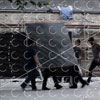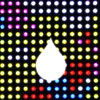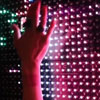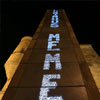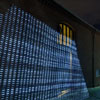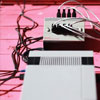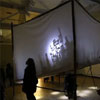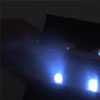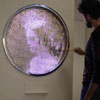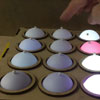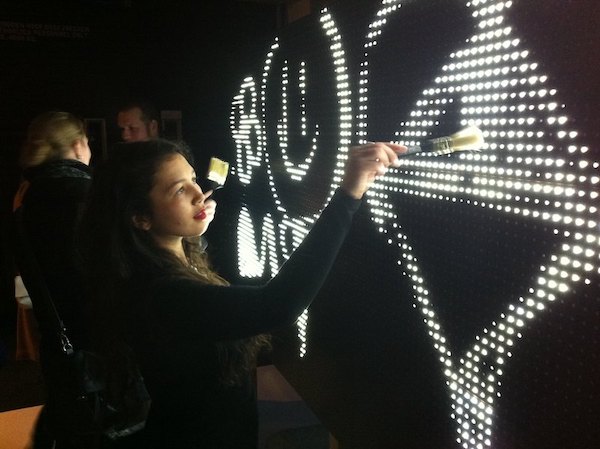
Waterlight Graffiti is a project that aims to create a material made of thousands of LEDs which lights up when touched by water. When it touches the frame of a LED, water creates an electrical bridge bringing the power required to light up the LED embedded under the surface. The wetter it is, the brighter it gets. Waterlight Graffiti’s purpose is to be a new kind of reactive material to draw or write ephemeral messages made of light. This project enables anyone to graffiti the wall of LEDs with a basic environment-friendly atomizer. To use water, which has neither shape nor colour, to draw light, is a magical experience, regardless of the public age or its artistic sensibility. By mixing a natural element and technology, Waterlight Graffiti’s users can even play with the weather or the evaporation speed for example. Water Light Graffiti also has a surprising role during rainy days and turn them into fireworks of damp LEDs.
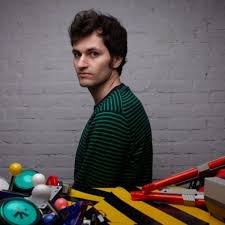
About the artist
Antonin Fourneau is a french artist and designer living in Paris. In 2005 he received an Art Diploma from Aix-en-Provence Art School, followed in 2007 by a post Diploma in Interactive Art in the Design School of EnsAD Paris. Since his graduation, Antonin has been focused on interactive art and popular culture. He created a collaborative project about innovation and a new form of funfair named Eniarof. He written a book about this project published at the 1980 editions. Most of his research focuses on creative interactions in large groups of people. As a part of his research, he was selected for a residency in Japan in 2007 at the Tokyo Wonder Site. Followed in 2008 by a residency at Medialab Prado in Madrid and Lorient as part of its research for the project Oterp a geolocalised music game. He took part in various exhibitions related to digital arts. In 2012 he created the famous piece Watertight Graffiti which received a lot of congratulations and still exhibited around the world today. He is currently professor in new media design in EnsAD where he leads the research group GoD|Art
Skills Applied
 PHYSICS OF MATERIALS
PHYSICS OF MATERIALS
 CODING/PROCESSING
CODING/PROCESSING
 ARDUINO
ARDUINO
 INTERACTIVE DESIGN
INTERACTIVE DESIGN
Message From The Artist
“In the 80s in France, the government decided to teach programming to primary school children and I had the chance to see and enjoy how my lines of code became images, animations and games. It was for me a Frankenstein feeling : it’s alive … alive !!! Much later, when I finished high school I wanted to rediscover this magic moment with coding. I must admit that learning to program fascinated me so much than I did not have any practice of drawing during many years despite the fact than when I was in middle and high school I spent my time caricaturing people. Later I wanted to simplify the experience that people could have with my works. I wanted to avoid using a computer to make something interactive and discovered that electronics was the best way to do this. Now my feeling is that material and technology can be mixed so easily that our vision of electronics will change a lot in the next years. Later during a trip to China in 2012, I discovered the Dishu practice (literally painting on the ground with water). I realized that this simple gesture could be transcended. With all these bright LED panels used to display mostly advertising in the street, I thought it would be interesting that citizens can also practice on supports as bright as these panels. The idea of Waterlight Graffiti came to me at that time. I have to confess that the French invention: etch a sketch by André Cassagnes has a lot of influence on me even today. This new work was therefore for me a perfect opportunity to pay tribute to this invention that every child had a day in their hands. You will see that all the experiences you have as children will have an obvious impact on your adult practice. The more curious you are, the more you will be able to dig into the abundant treasures that are the imagination of a child or teenager even 40 years later.” Antonin Fourneau
STEMarts Design Tool
The Stemarts Design Tool provides a step-by-step tool to help you come up with a design concept for an installation or sculpture inspired by the work of Paseo artists. Explore the artist’s work and theme to understand what makes it unique. Research the science and technology behind the art to inform your design. Then experiment with the related hands-on activities and tools provided in the STEAM wiki to better understand the artist techniques and process. Finally, Brainstorm with your peers to come up with ideas, and create an Installation Design Concept to share with your school. This tool will take you through each stage of the process. Just click on Explore to get started!
Explore water, light and electronics as a new interactive approach.
Antonin Fourneau combines water and light to create magical interactive experiences in public spaces. He believes that materials and technology can be combined in unique ways without a computer to create a new kind of interactive experience. In this activity the artist challenges you to come up with a Design Concept for an installation that applies this approach in working with water and light around the festival theme of connection. The first step is to learn more about how the artist creates installations in this way. Explore the artist page and STEAM wikis below, and search online, to better understand this genre of art. Try search terms like ‘electronic art’ or ‘water projection installation art’. Make a note of any installations that you like or do not like. At the end of the exploration review all your selections and reflect on the aspects of the design that you would like to investigate further.
Research the science and technology behind the work.
The next step is to hone in on a technology and materials that you want to focus on and research how it works. Check out the STEAM wiki below to try out some of the DIY experiments related to the artist’s work. What can you learn from these resources and the artist’s process? Even though this project does not require building the installation, it is still important to have an understanding of how they work in order to get ideas.
Brainstorm and experiment to see what’s possible.
Once you have identified the type of genre/installation that you resonated with and have gotten inspired by the possibilities you can start brainstorming on ideas for your own interactive installation. Start sketching out concepts and jotting down notes with ideas for an installation. Don’t try to edit at this point. Start a sketchbook just for this project and write or draw anything that comes to mind. This is where you let your imagination run wild!
Get Feedback and iterate.
This is the time to share your concept with peers and experts to get feedback and see how you can improve your design. Practice describing your concept. Discuss and listen to other people’s ideas and remain open to all new possibilities. There will be a lot of trial and error until you arrive at the final design. This stage is especially important to be sure your technical or engineering ideas are feasible. Check our Feedback Tool for some tips.
Create a design concept for an interactive water installation.
The next step is to do a final drawing that communicates your design for an interactive water and light installation. This could be done by hand or on a computer. The design should show what it will look like and the materials and technology you would use. It would consider possible sites and how people would interact with it. It can include diagrams, text, photos or anything you like. Most importantly it would show how your interactive installation explores the festival theme of connection. Since an installation is multidimensional you will have to find a unique and creative way to communicate your installation concept.
Share your concept with your school and visiting artist.
Once all the student drawings are complete they can be displayed in your school. It is fascinating to see the many different ideas and solutions. You can learn a lot by noticing different design approaches and you can share them with the artist when they visit the school. Have fun and don’t forget to share your work with us in the form of photos or videos! We would love to see what you learned.
STEMarts Wiki
The STEAM-wiki is a place to get started with your artist research. You will find links to articles, images, video, and tutorials that relate to Antonin Fourneau’s work.
You can search by clicking on the links below or you can click on the topic words in the word cloud for specific areas of interest. For example, INTERACTIVE WATER INSTALLATION to learn about this genre of work. If you are looking for STEM + Art activities type in STEAM Activities. To view all options, use the keyword ALL.
Remember the resource is an open forum sharing links and ideas that others have found – always check your sources and give credit where credit is due. The open source movement generously shares its knowledge and relies on user feedback – so if there’s something really good or doesn’t work let others know.
arduino Arduino projects artists art term art terms calligraphy chinese street art demo digital graffiti Dishu electrical conductivity ephemeral art experiment graffiti GRL hydroelectrodynamics installation art interactive art installation interface LED light media art microcontroller project public art sensor street art street art ephemeral art street calligraphers technology tutorial View All water water experiment water pump art


